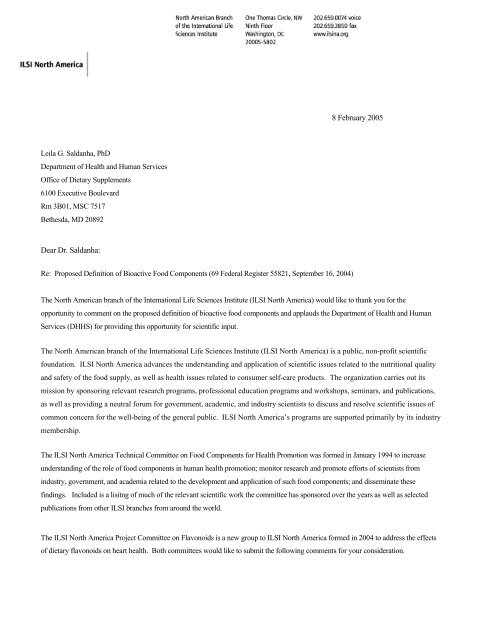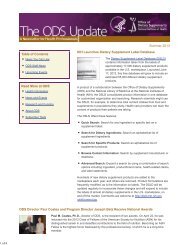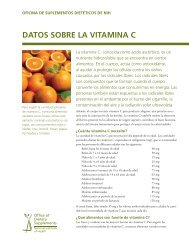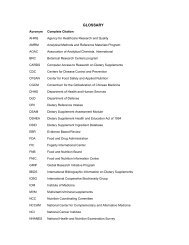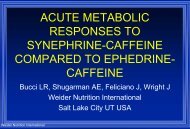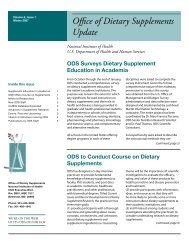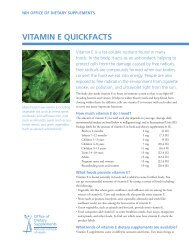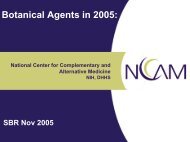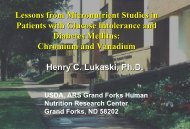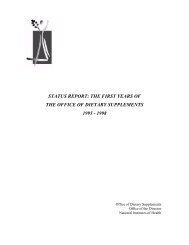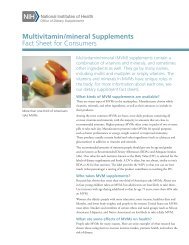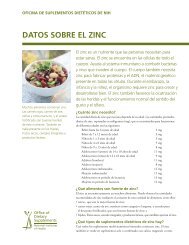September 13, 2001 - Office of Dietary Supplements
September 13, 2001 - Office of Dietary Supplements
September 13, 2001 - Office of Dietary Supplements
- No tags were found...
Create successful ePaper yourself
Turn your PDF publications into a flip-book with our unique Google optimized e-Paper software.
8 February 2005Leila G. Saldanha, PhDDepartment <strong>of</strong> Health and Human Services<strong>Office</strong> <strong>of</strong> <strong>Dietary</strong> <strong>Supplements</strong>6100 Executive BoulevardRm 3B01, MSC 7517Bethesda, MD 20892Dear Dr. Saldanha:Re: Proposed Definition <strong>of</strong> Bioactive Food Components (69 Federal Register 55821, <strong>September</strong> 16, 2004)The North American branch <strong>of</strong> the International Life Sciences Institute (ILSI North America) would like to thank you for theopportunity to comment on the proposed definition <strong>of</strong> bioactive food components and applauds the Department <strong>of</strong> Health and HumanServices (DHHS) for providing this opportunity for scientific input.The North American branch <strong>of</strong> the International Life Sciences Institute (ILSI North America) is a public, non-pr<strong>of</strong>it scientificfoundation. ILSI North America advances the understanding and application <strong>of</strong> scientific issues related to the nutritional qualityand safety <strong>of</strong> the food supply, as well as health issues related to consumer self-care products. The organization carries out itsmission by sponsoring relevant research programs, pr<strong>of</strong>essional education programs and workshops, seminars, and publications,as well as providing a neutral forum for government, academic, and industry scientists to discuss and resolve scientific issues <strong>of</strong>common concern for the well-being <strong>of</strong> the general public. ILSI North America’s programs are supported primarily by its industrymembership.The ILSI North America Technical Committee on Food Components for Health Promotion was formed in January 1994 to increaseunderstanding <strong>of</strong> the role <strong>of</strong> food components in human health promotion; monitor research and promote efforts <strong>of</strong> scientists fromindustry, government, and academia related to the development and application <strong>of</strong> such food components; and disseminate thesefindings. Included is a lisitng <strong>of</strong> much <strong>of</strong> the relevant scientific work the committee has sponsored over the years as well as selectedpublications from other ILSI branches from around the world.The ILSI North America Project Committee on Flavonoids is a new group to ILSI North America formed in 2004 to address the effects<strong>of</strong> dietary flavonoids on heart health. Both committees would like to submit the following comments for your consideration.
We suggest:1. Clarifying the need for a definition and its intended use2. Removing the descriptive term ‘bioactive’, or changing it to ‘physiologically-active’3. Modifying the definitionIt is stated that there is an interest in establishing a definition for ‘bioactive food components’ as a first step toward developingapproaches that might be used to assess their health effects. However, it is not clear why the definition is necessary. As background,the Food Components Committee spent a significant amount <strong>of</strong> time talking with the scientific community to work on the definition<strong>of</strong> “functional food.” Although a working definition was finally drafted, it seemed the dialogue around the definition took away fromresources that could have been spent on research. As an international organization, ILSI recognizes the international implications <strong>of</strong>this issue and itself tried to develop a definition. In the end, this effort resulted in a list <strong>of</strong> attributes, instead <strong>of</strong> a definition.Further clarification on why such a definition is needed and how it will be used needs to be clearly articulated. Definitions tend to setboundaries, and unless the reasons for the definition are clear, those boundaries can be arbitrary and artificial. Definitions may beused for strategic planning for scientific research, international arenas, and/or by regulatory agencies. Again, we urge DHHS to bethorough in spelling out the exact intended use and reason behind this definition as one definition may not be universally applicable.A challenge arises over use <strong>of</strong> the term ‘bioactive’, -- defined by Webster (1) as having “any effect on, interaction with, or responsefrom living tissue,” which invariably associates the food component with biologic or pharmacologic activity. For this reason, the term‘bioactive’ is not helpful in describing food components that are directly or indirectly physiologically active and result in healthpromotion or reduction in the risk <strong>of</strong> disease. For this reason, we believe a more scientifically accurate term would be“physiologically-active” food components. It might be useful to conduct consumer research to explore reactions to any proposedterminology.The DHHS Working Group proposed definition is:“Constituents in foods or dietary supplements, other than those needed to meet basic human nutritional needs, that are responsible forchanges in health status.” This definition presents several scientific concerns that can be remedied by appropriate word substitutions,as will be seen in the modified definition developed following consideration <strong>of</strong> the posed questions.ILSI North America proposes an alternate definition that addresses several scientific concerns that can be remedied by appropriateword substitution as follows:Physiologically-active food components: Food components demonstrated to result, directly or indirectly, in aconsistent positive physiological response linked to health promotion, or reduction in risk <strong>of</strong> disease, asmeasured through utilizing appropriate methodology and biomarkers.What categories/classes <strong>of</strong> compounds should and should not be considered as bioactive food components?Most, if not all, components found in food can be considered ‘bioactive’. These natural constituents in food canbe separated into distinct categories or classes by expression <strong>of</strong> their bioactivity. Those determined to cause,directly or indirectly, a consistent deleterious physiological response, as measured through in vitro or in vivo2
studies utilizing appropriate methodology and biomarkers, should not be considered in the proposed definition.This would include toxins and other contaminants.On the other hand, food components resulting in positive physiologic benefits, either directly or indirectly, should bethe focus <strong>of</strong> this definition. In order to be comprehensive, the definition should be as inclusive as possible. We dorecognize that at high enough doses any component could potentially have a harmful effect, but that is not the focushere.To further note how complicated the inclusion and exclusion criteria really are, it is impossible to completely includeor not include all compounds that fall under the main classes <strong>of</strong> plant secondary compounds. For example, onemight argue that monoterpenes should not be considered as ‘bioactive’ food components because they areresponsible for the smell and flavor <strong>of</strong> many plant foods, in particular herbs and spices. On the other hand,certain monoterpenes have anti-plaque bacteria properties, and does this fit into the proposed definition <strong>of</strong> abioactive food component as improving overall health status?(2) Some monoterpene flavor compounds are alsosuspected carcinogens. Therefore each component has to be looked at individually not as a class.Should essential nutrients be included as bioactive food components?Yes, classically, some physiologically-active food components have been called nutrients--essential nutrients forlife, and other nutrients for health currently classified as non-essential.Should synthetically derived components used in fortified foods and dietary supplements be considered under this definition?Yes, food components that are synthetically derived forms <strong>of</strong> natural compounds should also be considered underthis definition. For example, synthetic vitamins are food components with beneficial physiologic activities.Again, thank you for the opportunity to provide comments and we look forward to working with you on the scientific issuessurrounding the definition and its use.Sincerely,Richard M. Black, PhDExecutive Director, ILSI North AmericaRepresenting the compilation <strong>of</strong> comments received from the ILSI North America Technical Committee on FoodComponents for Health Promotion and the ILSI North America Project Committee on FlavonoidsEnclosure, Listing <strong>of</strong> ILSI sponsored scientific workReferences: 1. Webster’s New Universal Unabridged Dictionary. Barnes and Noble, Inc. 19962. J Dent Res. 1992 Jul;71(7):1431-8.3


